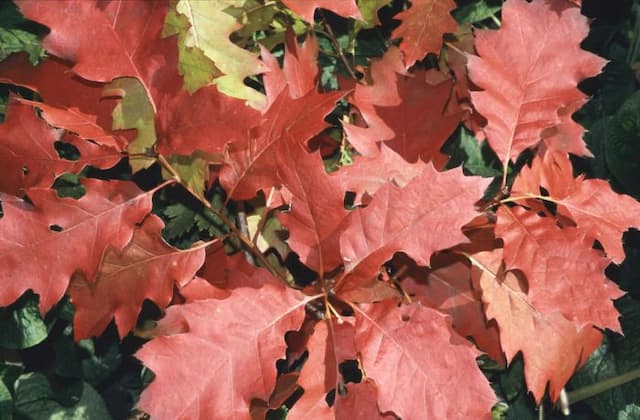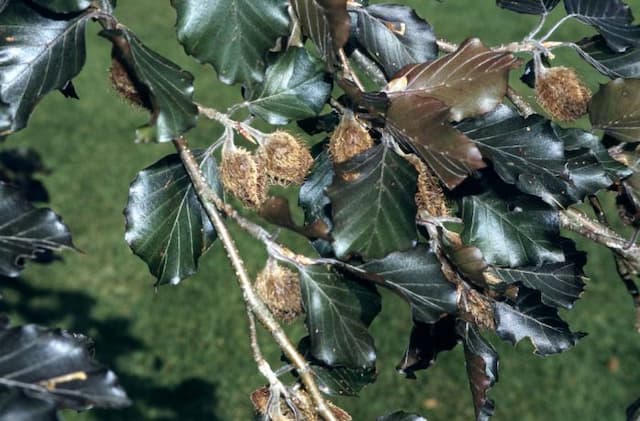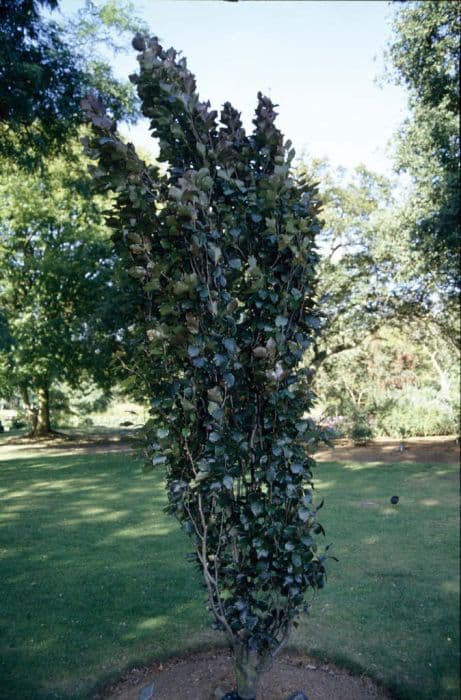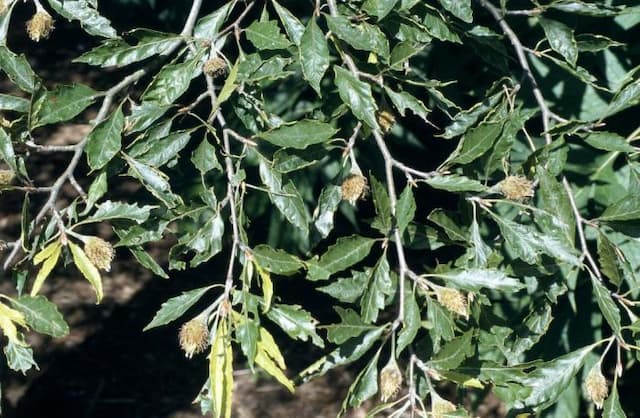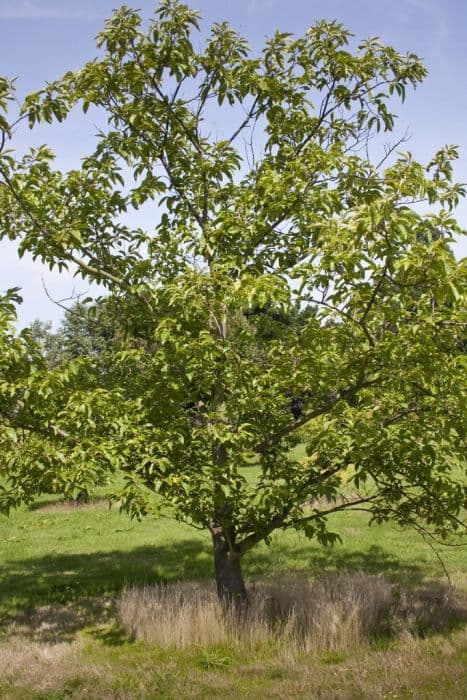English Oak Quercus robur (Fastigiata Group) 'Koster'

ABOUT
The Quercus robur 'Koster,' commonly known as the English oak, is a cultivar known for its distinctive growth habit and striking appearance. This oak presents with a strong central trunk from which branches extend upwards in a tight, columnar fashion. This erect growth gives it a somewhat narrow, conical shape, making it a standout among other trees. The English oak 'Koster' has dark green leaves that are deeply lobed, providing a classic oak silhouette. These leaves typically hold their color well into the fall before turning to shades of yellow and brown as the colder months approach. In spring, the tree produces long, yellow-green catkins, which are followed by the characteristic acorns that are beloved by wildlife. Acorns from the 'Koster' English oak are borne on lengthy stalks and have a classic, smooth cap that covers approximately one-quarter of the nut. They are a valuable food source for numerous birds and mammals. This tree's bark is rugged and furrowed, giving it a textured appearance that adds visual interest, especially during the winter months when the branches are bare. The overall presentation of Quercus robur 'Koster' is one of upright elegance and sturdiness, with its foliage providing a dense canopy during the growing season. Its unique form and resilient nature make it an attractive choice for landscapes seeking vertical accents or for areas with limited horizontal space.
About this plant
 Names
NamesFamily
Fagaceae
Synonyms
English Oak, Koster's Oak, Upright English Oak, Columnar English Oak
Common names
Quercus robur f. fastigiata, Quercus robur 'Fastigiata', Quercus robur var. fastigiata.
 Toxicity
ToxicityTo humans
The common name for Quercus robur (Fastigiata Group) 'Koster' is English Oak. Generally, the English Oak is not considered highly toxic to humans. However, the acorns and leaves, especially when young and in larger quantities, contain tannins and other compounds that can be toxic if ingested. Eating large amounts of acorns may lead to stomach upset, kidney damage, and other symptoms due to the tannin content. Symptoms might include nausea, vomiting, diarrhea, abdominal pain, and constipation.
To pets
The common name for Quercus robur (Fastigiata Group) 'Koster' is English Oak. Similar to its effects on humans, the English Oak can be toxic to pets, particularly dogs, cats, and horses, if they consume large amounts of the acorns or young leaves. The tannins in the acorns can cause gastrointestinal upset and potentially severe symptoms such as vomiting, diarrhea, abdominal pain, and constipation. Ingestion of a significant amount of acorns can lead to kidney damage or other complications. If you suspect your pet has ingested a large quantity of acorns or leaves from an English Oak, contacting a veterinarian would be advised.
 Characteristics
CharacteristicsLife cycle
Perennials
Foliage type
Deciduous
Color of leaves
Green
Height
50 feet (15 meters)
Spread
20 feet (6 meters)
Plant type
Tree
Hardiness zones
5
Native area
Europe
Benefits
 General Benefits
General Benefits- Shade Production: The dense canopy provides ample shade, making it ideal for parks and large gardens.
- Wildlife Habitat: Supports a variety of wildlife, offering shelter and food to birds and insects.
- Aesthetic Appeal: Known for its columnar form, it provides a striking visual element in landscapes.
- Durability: Has a robust growth habit and can withstand harsh weather conditions once established.
- Longevity: It's a long-lived species that can provide generations of enjoyment.
- Erosion Control: Its root system helps stabilize the soil and prevent erosion.
- Low Maintenance: Requires minimal care once established, apart from occasional pruning.
- Seasonal Interest: Offers year-round interest with its evergreen leaves, and seasonal acorn production.
- Acoustic Barrier: The dense foliage can help reduce noise pollution.
- Urban Tolerance: Adapted to urban environments, tolerating pollution and compacted soils.
 Medical Properties
Medical PropertiesThis plant is not used for medical purposes.
 Air-purifying Qualities
Air-purifying QualitiesThis plant is not specifically known for air purifying qualities.
 Other Uses
Other Uses- Acorn Meal Production: The acorns of the English oak can be dried, ground, and used as a flour substitute or a thickening agent in cooking and baking.
- Wildlife Habitat Creation: English oak can provide a vital habitat and nesting space for various bird species, as well as a food source for squirrels and other mammals in the form of acorns.
- Dye Production: The bark of the English oak has historically been used in tanning leather and can also produce a strong brown dye for textiles.
- Woodworking and Craft: The dense wood of the English oak is highly valued for carpentry, furniture making, and for crafting intricate items such as carving and woodturning.
- Ink Making: Gallnuts produced by the English oak, often as a result of wasp eggs, can be utilized to make iron gall ink, historically used in manuscripts.
- Smoking Food: Wood chips from the English oak are sometimes used in smoking meats and cheeses to add a distinct flavor.
- Shipbuilding and Repair: Traditionally, English oak has been sought after for its sturdy and water-resistant qualities, making it ideal for use in shipbuilding and repair.
- Fencing and Outdoor Structures: The wood is very durable, making it suitable for outdoor constructions such as fences, pergolas, and even children's play equipment.
- Acoustic Properties: Because of its density, English oak can be used in the construction of musical instruments and sound studios for its acoustic properties.
- Bonsai Cultivation: The English oak can be cultivated as a bonsai tree, which requires meticulous pruning and care to maintain its miniaturized form.
Interesting Facts
 Feng Shui
Feng ShuiThe English Oak is not used in Feng Shui practice.
 Zodiac Sign Compitability
Zodiac Sign CompitabilityThe English Oak is not used in astrology practice.
 Plant Symbolism
Plant Symbolism- Strength: The common name of Quercus robur 'Koster' is 'English Oak'. Oaks in general symbolize strength due to their hard wood and long life, making them a representation of enduring power.
- Stability: With its strong roots and resilient nature, English Oaks stand for stability and reliability, invoking feelings of trust and safety.
- Endurance: The longevity of oaks, with many living for hundreds of years, exemplifies endurance and staying power, suggesting that one can withstand challenges over time.
- Heritage: The English Oak is often a symbol of heritage and legacy, representing the connection to one's ancestry and the passage of traditions across generations.
- Wisdom: Old trees like the English Oak are frequently associated with wisdom owing to their age and the many life cycles they have witnessed.
- Nobility: Historically, the oak has been considered a noble tree, often linked with kings and nobility, partially due to its impressive presence and stature.
 Water
WaterThe English Oak 'Koster' prefers to be watered deeply and then allowed to dry out partially between waterings. During its growing season in spring and summer, water the tree approximately once a week with around 10 to 15 gallons depending on the size and age of the tree, as well as the soil type and weather conditions. Reduce the frequency of watering in the fall and further in winter to match the tree's dormant period. Always avoid overwatering, which can lead to root rot. During prolonged dry spells, additional watering may be necessary to maintain soil moisture.
 Light
LightEnglish Oak 'Koster' thrives best in full sun conditions, meaning it requires at least six hours of direct sunlight daily. This oak is best planted in a spot where it has ample space to receive unfiltered sun throughout the day. Avoid shaded areas, as insufficient light can impede growth and overall plant health.
 Temperature
TemperatureThe English Oak 'Koster' can tolerate a wide range of temperatures and is hardy in zones 5 through 8. It can survive winter temperatures as low as -20 to -10 degrees Fahrenheit. The ideal growing conditions for this tree are in regions where summer temperatures don't typically exceed 90 degrees Fahrenheit, although it is quite adaptable and can tolerate hotter conditions.
 Pruning
PruningPrune the English Oak 'Koster' primarily to remove any damaged, diseased, or dead branches to maintain its health and appearance. The best time for pruning is in late winter to early spring before new growth starts. Annual pruning may not be necessary, as oaks generally maintain a good shape naturally, but inspect the tree yearly and prune as needed to encourage a strong structure.
 Cleaning
CleaningNot needed
 Soil
SoilThe English Oak 'Koster' prefers well-drained, fertile soil with a pH range of 4.5 to 7.5. A soil mix of loam, compost, and sand in equal parts can support healthy growth.
 Repotting
RepottingThe English Oak 'Koster' seldom needs repotting as it is typically grown outdoors and can thrive without frequent soil changes.
 Humidity & Misting
Humidity & MistingEnglish Oak 'Koster' is adaptive and can tolerate a wide range of humidity levels; common ambient outdoor humidity is generally suitable.
 Suitable locations
Suitable locationsIndoor
Not suited for indoor growth; too large.
Outdoor
Plant in full sun, spacious area, deep soil; water deeply.
Hardiness zone
5-8 USDA
 Life cycle
Life cycleCommonly known as the English Oak 'Koster', Quercus robur begins its life as an acorn, the fruit of a mature tree, which germinates after falling to the ground. Upon germination, the acorn develops into a seedling with a primary root that extends into the soil and a shoot that grows towards the light. As the seedling grows, it develops into a sapling, characterized by the formation of branches and leaves, starting the process of photosynthesis. Over several decades, the sapling matures into an adult tree with a strong, straight trunk and a spreading crown of deep green, lobed leaves, becoming capable of producing acorns by the time it reaches 40 to 50 years old. During its mature stage, which can last several centuries, the English Oak 'Koster' provides habitat for wildlife, stabilizes soil, and contributes to its ecosystem. Eventually, as it reaches the senescence stage, growth slows, and it becomes more susceptible to environmental stress, diseases, and pests, until it dies and decomposes, returning nutrients to the soil and closing the cycle.
 Propogation
PropogationPropogation time
Late winter
The most popular method of propagating the English Oak, specifically the 'Koster' variety of the Fastigiata Group, is through acorn sowing. Acorns are collected in the fall when they drop from the tree and are planted immediately to prevent desiccation and preserve viability. The acorns are typically sown at a depth of 1-2 inches (2.5-5 cm) in well-drained, fertile soil with good exposure to sunlight. It's crucial to protect the acorns from wildlife, such as squirrels, which may dig them up. Germination occurs in the spring, and once the seedlings are large enough to handle, they may be transplanted to their permanent location. This process captures the genetic variation of the species, though some specific cultivar traits may not be faithfully reproduced through seed.

